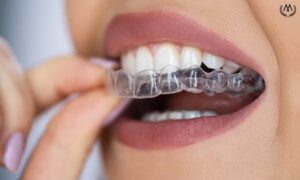Orthodontic treatment is an effective method for aligning your teeth. However, experiencing tooth sensitivity after treatment is possible. While treatments using MK Aligners are generally comfortable and hassle-free, tooth sensitivity may occur as a side effect. Here’s how to manage tooth sensitivity after orthodontic treatment:
1. Understand the Causes of Sensitivity
Tooth sensitivity after orthodontic treatment is often due to the movement of teeth and the adjustment period of the surrounding tissues. As teeth are moved through the aligners, pressure can be exerted on the tooth roots and surrounding tissues, leading to sensitivity. This is a normal part of the treatment process.
2. Practice Gentle Oral Care
To reduce sensitivity, practice gentle oral care. Use a soft-bristled toothbrush instead of a hard one and brush your teeth gently. Additionally, choose toothpaste formulated for sensitive teeth. These types of toothpaste can help form a protective layer on the tooth enamel, reducing sensitivity.
3. Consume Foods and Drinks at Moderate Temperatures
To minimize sensitivity, avoid consuming foods and drinks that are extremely hot or cold. These can exacerbate tooth sensitivity. Instead, opt for foods and drinks at moderate temperatures and eat slowly.
4. Use Protective Products
Consider using protective products recommended by your dentist to alleviate tooth sensitivity. Products like enamel-protecting gels or sensitivity-reducing sprays can be beneficial. Your dentist can recommend the most suitable product for your needs.
5. Follow Your Treatment Plan
It is crucial to adhere to your treatment plan with MK Aligners. Wear your aligners for the prescribed duration and change them regularly. Proper adherence ensures the treatment progresses correctly, which can reduce sensitivity and make the process more comfortable.
6. Stay in Touch with Your Dentist
If your sensitivity is severe or persists for an extended period, contact your dentist. They can assess your situation and provide specific recommendations. They might also suggest additional treatments or adjustments to alleviate the sensitivity.
7. Try Soothing Remedies
You can use soothing remedies to relieve sensitivity. For example, gargling with warm salt water can soothe your gums and reduce sensitivity. Additionally, applying natural remedies, such as aloe vera gel, may help relax your gums and alleviate discomfort.
8. Do Not Skip Regular Check-Ups
Do not miss your regular dental check-ups after orthodontic treatment. Your dentist will monitor the health of your teeth and gums, checking for any issues. Regular visits help prevent complications and ensure your treatment is on track.
Conclusion
Tooth sensitivity after orthodontic treatment can be managed with proper care and precautions. By practicing gentle oral hygiene, consuming moderate-temperature foods, and staying in communication with your dentist, you can effectively manage sensitivity during your MK Aligners treatment. These steps can help make your treatment more comfortable and maintain your dental health.





